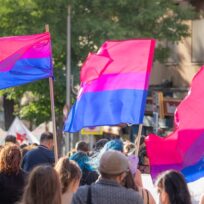When a show stars Riley Keogh and Lily Gladstone, you don’t think twice about watching it. It’s not just another murdered girl detective story, it is far more gripping and harrowing than that. A case that became about so much more than one girl taken far too soon, the story of Reena Virk, is not for the faint of heart. With a talented cast that extends past Lily and Riley, it’s easy to get so wrapped up in this series that you forget about the real case that inspired it. So what is the real story behind Under The Bridge, who killed Reena Virk, and more? Scroll down below for a breakdown of all the details.
Trigger warning: This show deals with themes of bullying, violence, and murder.
*There are also spoilers below.*
What Is Under The Bridge About?
The Hulu limited series follows the story of Reena Virk, a 14-year-old girl murdered in 1997 by her peers. It takes place in Saanich, a suburb of Victoria, British Columbia, Canada, in November 1997. Reena is invited out to a party and then attacked by a group of her friends. At some point, she drowns, and the series explores who was responsible for the death. Rebecca Godfrey (Riley Keough) is a local author who returns to write a story about young girls in Victoria but instead becomes embroiled in the case. She works with local police officer Cam Bentland (Lily Gladstone) to find out more, while their own past is brought to the surface.

Is Under The Bridge Based On A True Story?
“Based on actual events — Certain elements have been fictionalized or invented for dramatic purposes” is displayed at the start of each episode. Under the Bridge is based on the true story and the book written about it. Reena Virk was only 14 years old when she was beaten and drowned by a group of teenagers she believed to be her friends. The story caught the attention of the nation due to the senseless violence involved, and ignited a moral panic around teenage “girl violence” that remains today.
Rebecca Godfrey is also a real person. While writing her debut novel (2001’s The Torn Skirt), she was suddenly inundated with calls about the murder. She returned to her hometown to learn more and spent the following six years researching and interviewing the accused. She covered the gruesome case and its lasting effects in her 2005 book, Under the Bridge.
What Was Changed For The Series?
While Rebecca Godfrey did cover the story and was consulted for the series before her death in 2022, her role in the story has been heightened for dramatic effect. She wasn’t a central aspect of the investigation in that way but corresponded with local police.
Speaking of police, the character of Cam Bentland is an amalgamation of the police offers involved in the case. The choice to have Cam (played by Gladstone), an Indigenous woman adopted by white parents, allows the character to sympathize with Reena in a way her colleagues don’t. In episode 3, we discover that there is a history between Cam and Rebecca. First, through a photo of the two and Rebecca’s deceased brother, Gabe, and then when they start hooking up in a bar bathroom. It remains to be seen whether their relationship will progress or exactly what happened the first time around.
As for Gabe, the character is based on Rebecca’s brother, Jonathan Godfrey, who died at age 16 in 1981 when his sister was 13 years old. He fell from a local bluff and drowned, which may be why writers are weaving this tale with Reena’s drowning. We are yet to learn more about Gabe/Jonathan’s death, but according to the cast listing on IMDb, Teagan Stark is billed as “Gabe Godfrey” for one episode in the series as well as Georgia Acken as “young Rebecca,” which may suggest a flashback scene will occur in upcoming episodes.
The teenagers responsible have become known as the “Shoreline Six.” The real names for Warren Glowatski (played by Javon “Wanna” Walton) and Kelly Ellard (played by Izzy G.) were kept, while the names of Nicole Cook, Missy Grace Pleich, Nicole Patterson, Gail Ooms, and Courtney Keith were changed for the book and series. The captivating Josephine Bell is based on Nicole Cook and played by Chloe Guidry. Dusty’s real name is Missy Pleich, and she is played by Aiyana Goodfellow.
But the story of Reena, as harrowing and cruel as it is, seems to be very accurate to the real-life events.
What Happened To Reena Virk?
Reena was the daughter of two devout Jehovah’s Witnesses: an Indian father, Manjit, and an Indo-Canadian mother, Suman. She was bullied relentlessly by classmates for her religion and appearance. Reena was desperate to fit in with her peers, the majority of whom were white, and had begun rebelling against her parents.

In 1996, she falsely reported her father for sexual molestation and was briefly placed in foster care. The charges were quickly dropped, and she returned home. Around a year later, she was invited to a party by a group of schoolmates, including two she had met in the foster care system, and she eagerly accepted.
At approximately 11 p.m., Reena was confronted by a girl who accused her of spreading rumors about her, including that she wore false breasts, had AIDs, and wore colored contact lenses. She stubbed out a cigarette on Reena’s forehead before seven others joined her in the attack. The group assaulted Reena, who later managed to get up and stagger across the bridge to a bus stop to head home.
Who Killed Reena Virk?
Due to Reena’s history of running away from home, police didn’t initially suspect foul play when she was reported missing. But by Monday, rumors had begun circling around teenagers at the school, and police took the case more seriously.
Initially in Under the Bridge, we’re unsure of who killed Reena. For a brief moment, we wonder if she survived and did run away, as footage shows her leaving the assault, albeit heavily injured. Josephine Bell takes credit for the kill and brags about it but seems visibly shocked to discover Reena is actually dead. Reena’s body is discovered in the water eight days after the incident.
The autopsy report found extensive “internal injuries to her back and abdomen that were consistent with being kicked and stomped.” Her injuries were compared to those of a car crash victim. It turns out that two of the teenagers, Warren Glowatski (16) and Kelly Ellard (15) returned to Reena after the others had left. They dragged her back to the water, beat her, and then Ellard drowned her as Glowatski watched.

When questioned about the murder, Cook refused to answer questions about Ellard’s involvement, while Ellard claimed that Cook was the likely culprit and said she was being used as a scapegoat. Rebecca’s article for Vice claimed that the police found Reena’s jacket in Ellard’s closet with saltwater stains on it, consistent with water from the Gorge where Reena’s body was found, but Ellard claimed it was her own. Several other teens told the police that Glowatski and Ellard were the ones who ultimately killed Reena, and eventually, Glowatski confessed to the murder.

Reena Virk’s Killers Today
What happened to the teenagers involved in Reena’s attack and ultimate murder? The six girls who participated in the initial ambush but didn’t drown her were prosecuted in youth court. They were all convicted of assault causing bodily harm and received a 60-day conditional sentence to one year in jail.
The murder trial for Reena started in 1999. Glowatski had turned 18 and was tried as an adult. He was found guilty of second-degree murder. “Violence is not a recreational activity,” Justice Malcolm Macauley told Glowatski in court, “the death of Reena Virk and the shattered lives, including yours, are a testimony to that.” He was sentenced to life in prison with no chance of parole for seven years.
Ellard’s trial occurred in 2000, and she was also tried as an adult and convicted of second-degree murder. But her conviction was set aside on appeal, and a new trial was ordered. Over the years that followed, Ellard stood trial three more times for the murder of Virk, before the Supreme Court of Canada eventually upheld her original life sentence in 2009.
Glowatski spent seven years in federal prison before he was let out on day parole in 2007, allowing him to participate in public activities during the day before requiring him to return to prison or a halfway house by night. In 2010, when Glowatski was 29, he was granted full parole. He has gone through significant rehabilitation and been in touch with Virk’s parents and received their forgiveness. “We would have hoped that somebody would have learned something from this whole thing, and so far, it looks like Warren has done that,” Suman told reporters at the time. “Out of all the accused in this whole process, he’s the only one that’s done that.”
Ellard gave birth to her first child in 2016 after being allowed a conjugal visit with her federal parolee boyfriend. She gave birth again in 2022 but declined the opportunity for full parole, saying, “Situationally, I’m not ready.” As of 2023, she was continuing to serve day parole. Ellard has never reached out to Suman and Manjit; she maintained her innocence until 2016, when she was asked by the parole board who was responsible for Reena’s death and finally said, “I believe I am.”
What Happened To Reena Virk’s Parents?
Following the death of their daughter, Manjit and Suman worked with anti-bullying initiatives throughout Canada. They were awarded the Anthony J. Hulme Award of Distinction for their work in 2009.
In 2008, Manjit released Reena: A Father’s Story, a book about their experiences and the loss of their daughter. In it, he criticized the legal system for removing Reena from the family home amid her false sexual abuse allegations, as well as the trials following her death. “I think people have to also see that any normal family, no matter how they try hard to keep their family intact, they can be derailed by this system,” he told CBC News. “I think that’s what has happened here and I hope others can find something about the book that they can use in their lives.”
Suman spoke to the Victoria Times Colonist in 2009 about how talking to Glowatski helped her to process Reena’s murder. “You don’t really want to sit down and talk to the person who has taken your child’s life,” she said. “Seeing what he had to say for himself, it doesn’t make things right or take away the pain, but you can let go of the questions you have and put it behind you. It gave us a voice to say whatever we needed to.”






















































